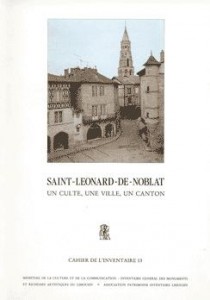
According to tradition and the legendary account of his life written in the 11th century, Leonard was born at the end of the 5th century into a family of officers at the court of King Clovis. Leonard was baptised by Saint Remi, the Bishop of Reims when Clovis, King of the Franks, Carried him to the baptismal font. He became a disciple of Saint Remi and was encouraged by his master to visit the poor and the sick. He received the right from the King to free the prisoners whom he visited and judged capable of benefitting from the right of amnesty, from their chains.
The King gave Leonard the opportunity to take on some important missions and to become a Bishop, but he refused with these words :- « Your Majesty, give those who desire it, the pontifical mitre. As for me, I shall be glad to give praise to the Lord, by living a solitary life ».
He left the Royal Court with his brother Liphard and spent some time in the Monastery of Micy (Saint Mesmin) whose leader was the Abbot Maximin. He was ordained as a deacon then continued on his route towards the south, while continuing to evangelise the people he met en route. He decided to to instal a hermitage in the forest of Pauvain on the banks of the river Vienne, not far from Limoges, where the tomb of Saint Martial, the first Bishop of Limoges, was to be found.
While the wife of the King of Aquitaine was in residence in her castle which was situated on the other side of the Vienne from the hermitage of Leonard, and who had come there with her husband for the hunt, she arrived at the term of a pregnancy and had great difficulty giving birth. Leonard was called to her bedside and through the intercession of his prayers, the Queen and the child were saved.
In recognition, the King offered many gifts to Leonard, which he refused and asked that they be given to the poor. However, he accepted the territory of the forest which he on his donkey could ride around in 24 hours. He gave this territory the name of “Noblac” to show the royal origin of this gift and the priviledges which were attached to it. The hermit Leonard built a chapel in honour of Our Lady and Saint Remi, which came to be called « Our Lady Beneath the Trees ». He asked two monks to help him and he installed them near his hermitage. For them and for the first inhabitants of Noblat, he miraculously caused a well of water to start flowing.
His reputation for holiness spread well beyond the Limousin. He welcomed many prisoners who had been freed through his intercession and gave them land to cultivate so that they would turn their backs on their previously disordered lives.
On a 6th of November, the hermit Leonard, patron saint of prisoners, died and his body was entombed in the chapel he had built. His tomb rapidly became a place of pilgrimage, thus giving birth to the town which, ever since, has borne his name SAINT LEONARD DE NOBLAT.
________________________
_______________________
Bibliography :
About saint :
The first biography of saint Léonard is the Vita, œuvre book written around 1030.
After Joseph du Chalard‘s biography in 1624, we can count a new one each century : by P. Rougerie (en religion : Bernardin-de-tous-les-saints) in 1681, by the abbot Oroux in 1760, & the last one byabbot Arbellot in 1863.
Each has it’s particularities depending of the period it was written.
About the Saint & the town :
